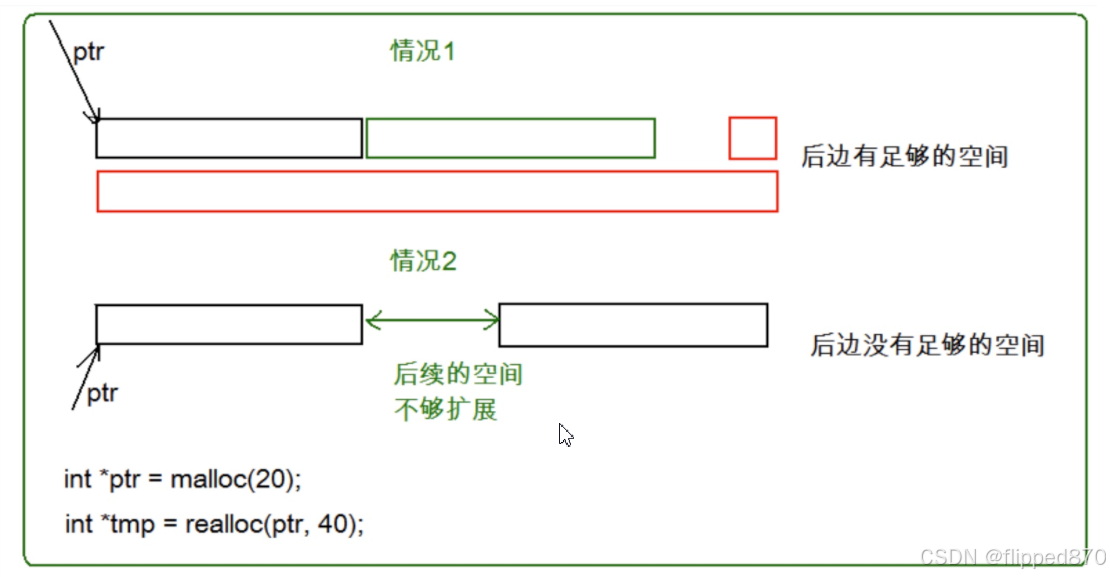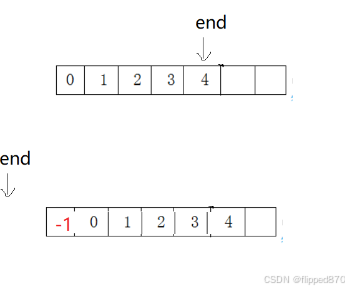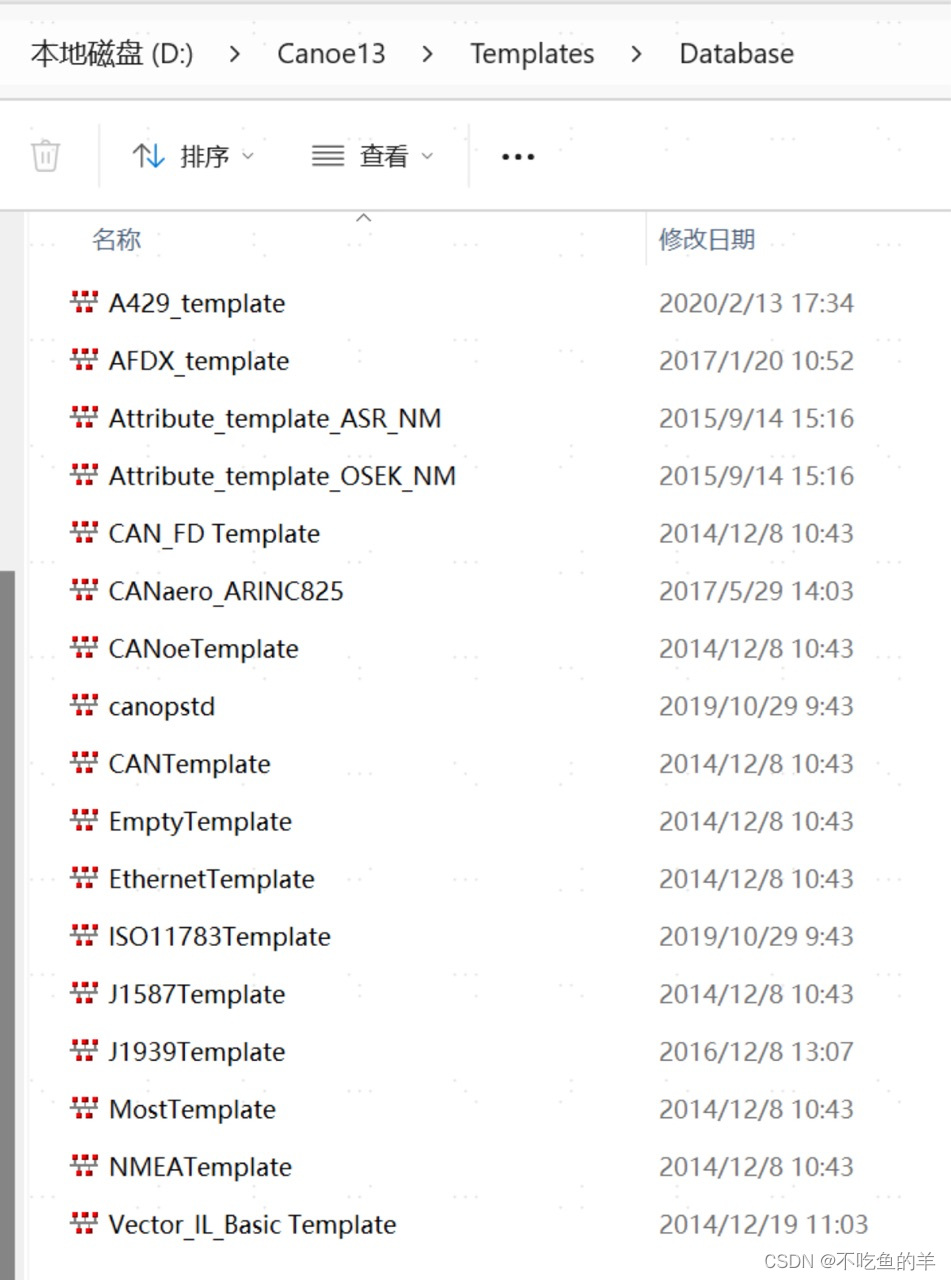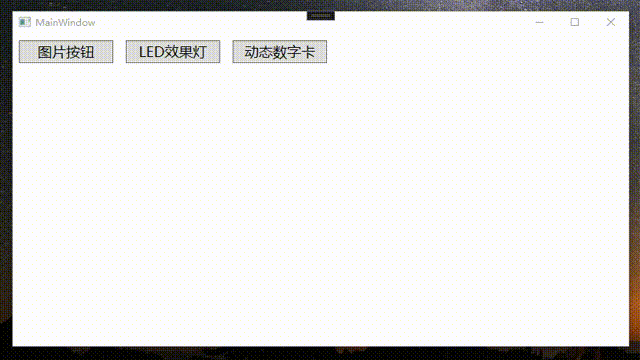一、引言
首先我们应该回顾动态内存开辟的原理 这部分知识对于内存访问至关重要 然而顺序表的实现都是基于C语言的基础 包括指针 结构体 动态内存开辟 realloc malloc h函数的使用与实现
既然要学习顺序表 我们不仅要知道这个实现是基于C语言知识的基础 我们还要知道什么是表 应该先知道线性表
二、线性表
线性表(linear list)是n个具有相同特性的数据元素的有限序列。 线性表是一种在实际中广泛使用的数据结构,常见的线性表:顺序表、链表、栈、队列、字符串...
线性表在逻辑上是线性结构,也就说是连续的一条直线。但是在物理结构上并不一定是连续的,线性表在物理上存储时,通常以数组和链式结构的形式存储
三、顺序表
顺序表是用一段物理地址连续的存储单元依次存储数据元素的线性结构,一般情况下采用数组存储。在数组上完成数据的增删查改。
顺序表一般可以分为:
1. 静态顺序表:使用定长数组存储元素。
2. 静态顺序表:使用动态开辟的数组存储。
接下来我们通过代码实现顺序表的各种功能 。
1.静态顺序表与动态顺序表 对比
//静态顺序表
typedef int SLDataType;
#define N 1000
typedef struct SeqList
{
SLDataType a[N];
int size;//有效数据个数
}SL;
typedef int SLDataType;
#define INIT_CAPACITY 4
typedef struct SeqList
{
SLDataType* a;
int size;//有效数据个数
int capacity;//空间容量
}SL;
设置成动态的顺序表好处是 可以按需申请空间 相比于静态顺序表 会导致开少了不够用开多了浪费 SLDataType* a ; 这个就可以看作是int*a 由于typedef 定义的是int 4个字节 因为我们创建的是一个表 不能直接指明是什么类型 只能我们自己定义 定义结构体 定义我们所需的 变量
2.顺序表的初始化
void SLInit(SL* ps)
{
assert(ps);
ps->a = (SLDataType*)malloc(sizeof(SLDataType) * INIT_CAPACITY);//开辟内存空间
if (ps->a == NULL)
{
perror("malloc fail");//显示错误原因
return;
}
ps->size = 0;
ps->capacity = INIT_CAPACITY;
}
3.顺序表的销毁
将里面的元素置为空 里面的有效空间个数 和有效的数据个数 置为0
void SLDestroy(SL* ps)
{
assert(ps);
free(ps->a);
ps->a = NULL;
ps->capacity = ps->size = 0;
}4.顺序表的打印
通过循环遍历的方式 打印顺序表中的元素个数
SLDataType* a ; 指针就是数组
void SLPrint(SL*ps)
{
assert(ps);
for (int i = 0; i < ps->size; i++)
{
printf("%d ", ps->a[i]);
}
}5.顺序表的检查
主要检查顺序表是否满足扩容的空间
realloc与malloc函数的区别
realloc函数的出现让动态内存管理更加灵活。
有时会我们发现过去申请的空间太小了,有时候我们又会觉得申请的空间过大了,那为了合理的时
候内存,我们一定会对内存的大小做灵活的调整。那 realloc 函数就可以做到对动态开辟内存大小
的调整。
void* realloc (void* ptr, size_t size);
函数原型如下:
ptr 是要调整的内存地址
size 调整之后新大小
返回值为调整之后的内存起始位置。
这个函数调整原内存空间大小的基础上,还会将原来内存中的数据移动到 新 的空间。
realloc在调整内存空间的是存在两种情况:

情况1
当是情况1 的时候,要扩展内存就直接原有内存之后直接追加空间,原来空间的数据不发生变化。
情况2
当是情况2 的时候,原有空间之后没有足够多的空间时,扩展的方法是:在堆空间上另找一个合适大小的连续空间来使用。这样函数返回的是一个新的内存地址。
malloc主要用来直接开辟一块空间
realloc主要用来扩容,就是开辟一块新的空间,将之前的空间释放掉 realloc扩容分为原地扩容 就是 后面的空间还有 异地扩容没有连续的空间 被被人占用了
注意 这种情况下的扩容就是将原来空间里的内容放到新的空间 然后把之间没扩容的空间销毁掉 注意 这里的销毁不是真的销毁 而是把这些内存空间还给操作系统
void SLCheckCapacity(SL* ps)
{
assert(ps);
if (ps->size == ps->capacity)
{
SLDataType* tmp = (SLDataType*)relloc(ps->a, sizeof(SLDataType)*ps->capacity * 2);
if (tmp == NULL)
{
perror("realloc fail");
return;
}
ps->a = tmp;
ps->capacity *= 2;
}
}6.顺序表的尾插
ps->a[ps->size] = x; ps是结构体指针,访问a之后,a是一个数组,可以通过下标去访问,ps还有一个成员是size,作为下标访问之后,将x的值赋值给这个元素
void SLPushBack(SL* ps, SLDataType x)
{
assert(ps);
//扩容
SLCheckCapacity(ps);
ps->a[ps->size] = x;
ps->size++;
ps->a[ps->size++] = x;
}7.顺序表的尾删
void SLPopBack(SL* ps)
{
assert(ps);
assert(ps->size > 0);
ps->size--;
}8.顺序表的头插

void SLPushFront(SL* ps, SLDataType x)
{
assert(ps);
SLCheckCapacity(ps);
int end = ps->size - 1;
while (end >= 0)
{
ps->a[end + 1] = ps->a[end];
--end;
}
ps->a[0] = x;
ps->size++;
}9.顺序表的头删

void SLPopFront(SL* ps)
{
assert(ps);
assert(ps->size > 0);
int begin = 1;
while (begin < ps->size)
{
ps->a[begin - 1] = ps->a[begin];
begin++;
}
}10.顺序表的插入
解释:顺序表的元素插入和插队是一个意思的。想象一下,有一个人要插队,他要插到第3个位置去,那么他前面的两个人不用动,而他后面的人都得动。具体步骤是:最后面的那个人后退一个位置,倒数第二个人后退到原来最后一个人的位置,这样子后面的每个人依次后退,最后就空出来了一个位置,这个人就插队进去了。顺序表也是这么插入的。有效元素size+1
元素插入有一些要求:
1.元素下标是否越界(有没有插队到奇怪的位置)
2.顺序表存储空间是否满了(有没有位置让shi是你插队)
 size - 1是有效数组的下一个位置
size - 1是有效数组的下一个位置
void SLInsert(SL* ps, int pos, SLDataType x)
{
assert(ps);
assert(pos>=0&&pos<=ps->size);
SLCheckCapacity(ps);
int end = ps->size - 1;
while (end >= pos)
{
ps->a[end + 1] = ps->a[end];
--end;
}
ps->a[pos] = x;
ps->size++;
}11.顺序表的删除
删除和插入的操作类型,比如一群人在排队,有一个人有事临时走了,那么这个人的位置就空出来了,后面的人就一个个往前一步,补上这个空位。
元素删除有一些要求:
1.元素下标是否越界(走的人是不是这个排队里面的人)
2.顺序表存储空间是否为空(有没有人可以走)
void SLErase(SL* ps, int pos)
{
assert(ps);
assert(pos >= 0 && pos<ps->size);
int begin = pos + 1;
while(begin<ps->size)
{
ps->a[begin - 1] = ps->a[begin];
begin++;
}
ps->size--;
}12.顺序表的查找
顺序表又随机存取功能 可以通过直接利用数组下标查找
//
int SLFind(SL* ps, SLDataType x)
{
assert(ps);
for (int i = 0; i < ps->size; i++)
{
if (ps->a[i] == x)
{
return i;
}
}
return -1;
}四、顺序表的完整版代码
其中头插 尾插 头删 尾删 这些内容都在插入删除中 都可被替代
代码的实现是在VS2022编译器下完成的 首先我们要创建3个文件夹 逻辑的测试text .c 顺序表的实现SeqList.h SeqList.c
#define _CRT_SECURE_NO_WARNINGS
#include"SeqList.h"
void SLInit(SL* ps)
{
assert(ps);
ps->a = (SLDataType*)malloc(sizeof(SLDataType) * INIT_CAPACITY);//开辟内存空间
if (ps->a == NULL)
{
perror("malloc fail");//显示错误原因
return;
}
ps->size = 0;
ps->capacity = INIT_CAPACITY;
}
void SLDestroy(SL* ps)
{
assert(ps);
free(ps->a);
ps->a = NULL;
ps->capacity = ps->size = 0;
}
void SLPrint(SL*ps)
{
assert(ps);
for (int i = 0; i < ps->size; i++)
{
printf("%d ", ps->a[i]);
}
}
void SLCheckCapacity(SL* ps)
{
assert(ps);
if (ps->size == ps->capacity)
{
SLDataType* tmp = (SLDataType*)realloc(ps->a, sizeof(SLDataType)*ps->capacity * 2);
//
if (tmp == NULL)
{
perror("realloc fail");
return;
}
ps->a = tmp;
ps->capacity *= 2;
}
}
void SLPushBack(SL* ps, SLDataType x)
{
assert(ps);
//扩容
SLCheckCapacity(ps);
ps->a[ps->size] = x;
ps->size++;
ps->a[ps->size++] = x;
}
void SLPopBack(SL* ps)
{
assert(ps);
assert(ps->size > 0);
ps->size--;
}
void SLPushFront(SL* ps, SLDataType x)
{
assert(ps);
SLCheckCapacity(ps);
int end = ps->size - 1;
while (end >= 0)
{
ps->a[end + 1] = ps->a[end];
--end;
}
ps->a[0] = x;
ps->size++;
}
void SLPopFront(SL* ps)
{
assert(ps);
assert(ps->size > 0);
int begin = 1;
while (begin < ps->size)
{
ps->a[begin - 1] = ps->a[begin];
begin++;
}
}
void SLInsert(SL* ps, int pos, SLDataType x)
{
assert(ps);
assert(pos>=0&&pos<=ps->size);
SLCheckCapacity(ps);
int end = ps->size - 1;
while (end >= pos)
{
ps->a[end + 1] = ps->a[end];
--end;
}
ps->a[pos] = x;
ps->size++;
}
void SLErase(SL* ps, int pos)
{
assert(ps);
assert(pos >= 0 && pos<ps->size);
int begin = pos + 1;
while(begin<ps->size)
{
ps->a[begin - 1] = ps->a[begin];
begin++;
}
}
int SLFind(SL* ps, SLDataType x)
{
assert(ps);
for (int i = 0; i < ps->size; i++)
{
if (ps->a[i] == x)
{
return i;
}
}
return -1;
}#include<stdio.h>
#include<stdlib.h>
#include<assert.h>
typedef int SLDataType;
#define INIT_CAPACITY 4
#define N 1000
//动态顺序表
typedef struct SeqList
{
SLDataType* a;
int size;//有效数据个数
int capacity;//空间容量
}SL;
//
//typedef struct SeqList
//{
// SLDataType a[N];
// int size;//有效数据个数
//
//}SL;
void SLInit(SL* ps);
void SLDestroy(SL* ps);
void SLPrint(SL* ps);
void SLCheckCapacity(SL* ps);
void SLPushBack(SL* ps, SLDataType x);
void SLPopBack(SL* ps);
void SLPushFront(SL* ps, SLDataType x);
void SLPopFront(SL* ps);
void SLInsert(SL* ps, int pos, SLDataType x);
void SLErase(SL* ps, int pos);
int SLFind(SL* ps, SLDataType x);
时间复杂度 和头删 头插 尾删 尾插
要考虑最坏的情况, 单独插入的话,头插,需要挪动n个元素,实践复杂度为O(n)
![疯狂Spring Boot讲义[推荐1]](https://i-blog.csdnimg.cn/direct/51df7facbb53495ca22079ff2d1f2204.jpeg)


















